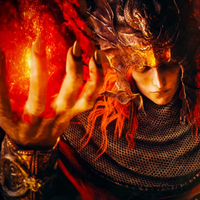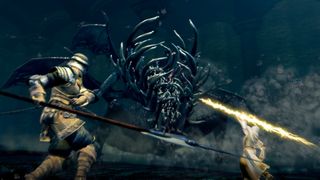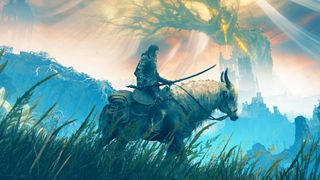The DLC’s similarities to Dark Souls seems to have caught a lot of people by surprise.
Shadow of the Erdtree echoes the original Dark Souls in several ways. For me, that’s a boon; it’s a huge reason why I liked it so much. Give me a tightly wound map with areas stacked on top of each other and I’m fully in. But as frustration over the DLC’s difficulty continues to be the talking point—which prompted FromSoftware to issue a patch this week to ease the challenge a bit—it’s clear that not everyone wanted or even expected Elden Ring to go full Dark Souls.
And I think that’s the problem: Much of Elden Ring’s success comes from its wide open world and the number of ways you can approach combat in it. Shadow of the Erdtree squeezes everything into a denser map, has fewer dungeons and miscellaneous items, and doesn’t warn you in big neon lights that your character is significantly weaker than even the regular enemies in the Land of Shadow. It’s an abrupt shift from the pacing of the original game—which many players likely haven’t touched for two years—and the smaller scale funnels you toward its main dungeons faster.
One of my main criticisms of Elden Ring is that the second half has no idea how powerful you are, and the difficulty of combat becomes wildly inconsistent as a result. Most players who have combed every inch of the Lands Between will tear through the back half of the game, while someone who has largely run from boss to boss might struggle. During the one week review period, I was forced into being one the latter. It felt like I was playing the hardest FromSoft game I’d ever played. But that’s not how most people ended up playing Elden Ring—and it’s certainly not how I experienced it on subsequent runs, because so much of the game was about growing more powerful with every conquest, big or small.
FromSoft probably felt that it was necessary to ‘reset’ the difficulty of the DLC, to align both types of players, via the Scadutree Fragments—the items you find throughout Shadow of the Erdtree that significantly raise your damage and defenses. On paper this makes perfect sense to me, especially if it wanted to avoid having certain players breeze through it with others struggling to kill the first boss.
One of our favourite co-op survival games – Core Keeper – is getting two new classes as it hits full release this summer.
The problem, I think, is the disparity between the types of players who come to FromSoft games for the raw ‘1v1 me bro’ challenge and those who played Elden Ring and gradually crested that challenge by clearing every inch of the map —which is obviously a valid way to play it.
But in the DLC, Elden Ring’s flexibility has now become its curse.
When everyone is taken back down to the equivalent of being low level, almost nobody is happy. As the criticisms and discussions over the DLC’s difficulty have continued, I’ve seen just how many different ways people approached Elden Ring. Some people min-maxed every item until they had an unstoppable build with a recipe of buffs to apply before every fight, some hunted down every cheesy strategy they could find, and others cruised through the game extremely overleveled either from killing a certain crow over and over or spending hundreds of hours exploring. This was a huge part of the success of Elden Ring: Anyone could play it and find their way through it. But in the DLC, that flexibility has now become its curse as players who were used to a very different game have been forced to adjust.

Welcome back, Dark Souls

If Shadow of the Erdtree has any flaw, it’s how little it does to explain how important your Scadutree Blessing level is compared to your rune level. In my experience with Elden Ring, my rune level never felt like the reason I was struggling against a boss. I usually could see the attacks I was failing to dodge or the tiny amount of damage I was doing due to the enemy’s resistances. It only ever got in the way when there was a certain weapon or spell I wanted to use that had a specific stat requirement. The DLC, however, requires you to pay attention to your damage and defenses in a way the base game only did if you were barely keeping up with the difficulty of the dungeons and bosses.
The biggest gaming news, reviews and hardware deals
Keep up to date with the most important stories and the best deals, as picked by the PC Gamer team.Contact me with news and offers from other Future brandsReceive email from us on behalf of our trusted partners or sponsorsBy submitting your information you agree to the Terms & Conditions and Privacy Policy and are aged 16 or over.
In Dark Souls, this level balance was embedded in the design of the game. You couldn’t just teleport around to different bonfires and farm up some runes; you had to make a trek through nasty enemies and precarious dungeons to get to a new place. So, naturally, people didn’t explore a lot, despite the number of rewards you’d get for doing so. Not only would you likely gain a few levels from your travels, but you’d find items that could be essential for other parts of the game, like the anti-poison Spider Shield—which was specifically not found in the area known for poison. Half the reason Dark Souls is known for its brutal difficulty is that it was probably a little too hands-off about directing people who wanted to leverage its RPG systems to gain an advantage over whatever obstacle they were on, even though the opportunity was very much there.
Shadow of the Erdtree’s approach to progression has a similar issue, especially as a follow-up to Elden Ring main campaign: As many people are finding out now that it’s been available for almost a week, you can access most areas without killing a single critical boss. The map is designed for you to explore and find out what’s easy enough for you to accomplish before returning to Belarut or one of the critical path dungeons. That’s why the Scadutree Fragments are all over the place—some are rewards for beating dungeon bosses, but many are just out there waiting to be found. The DLC is trying to tempt you away from the main path without spoiling the fact that the single plateau you start on is actually connected to almost every area in the DLC. One of the early NPCs, Sir Ansbach, even gives you a quest to go galloping around the map.
Maybe because of the smaller size or the lack of blunter signposting for the Scadutree Fragments, but it seems like a lot of people walked into the Land of Shadow thinking they could do what they did by the end of the base game and immediately conquer everything in front of them. Or assume every boss within the same region as roughly equal in “level.” But as director Hidetaka Miyazaki recently told The Guardian, Elden Ring, and many of FromSoft’s games are about “the sense of achievement” from overcoming difficult hurdles. “Turning down difficulty would strip the game of that joy—which, in [his] eyes, would break the game itself.”

Shadow of the Erdtree is what happens when that tighter approach to difficulty is applied to a game in which people have already overcome so many hurdles and tasted what it was like to be powerful enough to become Elden Lord.
The Land of Shadow is quite literally the shadow of the Lands Between. While everyone enjoyed the golden era of the Erdtree, the people in the Land of Shadow suffered and hardened themselves through torment. Part of the wake-up call of the DLC is that, despite claiming the throne as Elden Lord, there are people in the world whose hurdles were much greater than yours. And unsurprisingly, they fight you with a fury you haven’t seen before. To me, the surprise jump in difficulty communicates that you had it rather easy in the Lands Between and need to learn what it’s like surviving in a place an Elden Lord couldn’t ever fix.
Much like Lordran in Dark Souls, The Land of Shadow has been doomed for hundreds of years before you showed up. The sudden difficulty is the whole point and it’s trying to force you to adapt.
If you could just stick with every tactic from the Lands Between, there’d be no reason to try out all the new weapons and spells. And it would be hard to convince anyone to scour the map for items if everything was a cakewalk. That said, I still sympathize with the people who were caught off guard by early bosses like the Blackgaol Knight and the Dancing Lion. Both bosses seem to be intentionally difficult compared to the base game to give you an idea of what you’re up against. But just like getting crushed by Margit early in the original game, that should be your clue that you either need to practice the fight or find some ways to strengthen your character before you return.
Dark Souls stuck to this philosophy in its design and you either liked it or you didn’t. Elden Ring took a risk and injected it into a game that gave you a ton of ways to circumvent its hardest challenges. Personally, I loved all the ways the DLC made me reflect on my journey in the original game, and it reminded me of why I prefer a smaller map where FromSoft has more granular control over what you run into. It made Shadow of the Erdtree resonate more strongly than the original game, because the difficulty never felt like it was tuned as a haphazard guess as to how powerful I was.
Shadow of the Erdtree is what happens when that tighter approach to difficulty—made to illustrate the hostility of its world—is applied to a game in which people have already overcome so many hurdles and tasted what it was like to be powerful enough to become Elden Lord. But for anything in the DLC to work, thematically or mechanically, it needed to gut-punch you with a jump in difficulty, to expose you to a much harsher world where you need to use everything at your disposal to survive it
